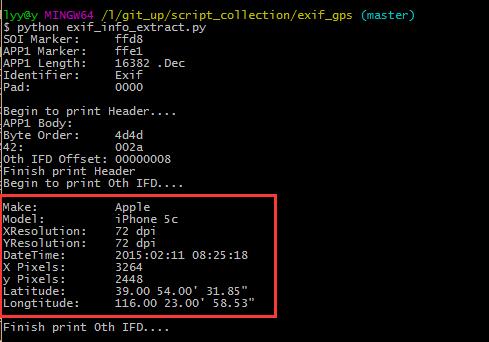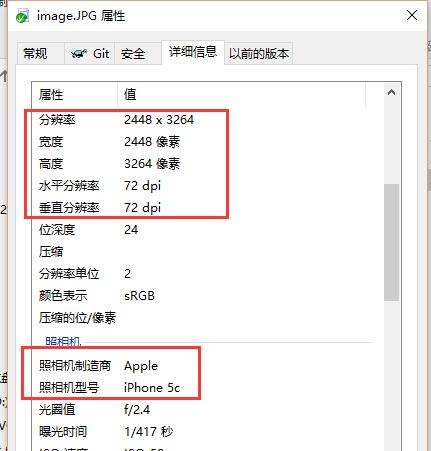 Backend Development
Backend Development
 Python Tutorial
Python Tutorial
 Implementation method of reading image attribute information in Python
Implementation method of reading image attribute information in Python
Implementation method of reading image attribute information in Python
This article uses a Python script to read image information. There are several instructions as follows:
1. Error handling is not implemented
2. All information is not read, probably only GPS information, Picture resolution, picture pixels, equipment manufacturer, shooting equipment, etc.
3. After simple modification, it should be possible to violently modify the GPS information of the picture
4. But for pictures that do not have GPS information themselves, The implementation is very complex and requires careful calculation of the offset of each descriptor.
After the script is run, the reading results are as follows

View here and Windows properties The content read by the device is exactly the same

The source code is as follows
# -*- coding:utf-8 -*-
import binascii
class ParseMethod(object):
@staticmethod
def parse_default(f, count, offset):
pass
@staticmethod
def parse_latitude(f, count, offset):
old_pos = f.tell()
f.seek(12 + offset)
latitude = [0,0,0]
for i in xrange(count):
byte = f.read(4)
numerator = byte.encode('hex')
byte = f.read(4)
denominator = byte.encode('hex')
latitude[i] = float(int(numerator, 16)) / int(denominator, 16)
print 'Latitude:\t%.2f %.2f\' %.2f\"' % (latitude[0], latitude[1], latitude[2])
f.seek(old_pos)
@staticmethod
def parse_longtitude(f, count, offset):
old_pos = f.tell()
f.seek(12 + offset)
longtitude = [0,0,0]
for i in xrange(count):
byte = f.read(4)
numerator = byte.encode('hex')
byte = f.read(4)
denominator = byte.encode('hex')
longtitude[i] = float(int(numerator, 16)) / int(denominator, 16)
print 'Longtitude:\t%.2f %.2f\' %.2f\"' % (longtitude[0], longtitude[1], longtitude[2])
f.seek(old_pos)
@staticmethod
def parse_make(f, count, offset):
old_pos = f.tell()
f.seek(12 + offset)
byte = f.read(count)
a = byte.encode('hex')
print 'Make:\t\t' + binascii.a2b_hex(a)
f.seek(old_pos)
@staticmethod
def parse_model(f, count, offset):
old_pos = f.tell()
f.seek(12 + offset)
byte = f.read(count)
a = byte.encode('hex')
print 'Model:\t\t' + binascii.a2b_hex(a)
f.seek(old_pos)
@staticmethod
def parse_datetime(f, count, offset):
old_pos = f.tell()
f.seek(12 + offset)
byte = f.read(count)
a = byte.encode('hex')
print 'DateTime:\t' + binascii.a2b_hex(a)
f.seek(old_pos)
# rational data type, 05
@staticmethod
def parse_xresolution(f, count, offset):
old_pos = f.tell()
f.seek(12 + offset)
byte = f.read(4)
numerator = byte.encode('hex')
byte = f.read(4)
denominator = byte.encode('hex')
xre = int(numerator, 16) / int(denominator, 16)
print 'XResolution:\t' + str(xre) + ' dpi'
f.seek(old_pos)
@staticmethod
def parse_yresolution(f, count, offset):
old_pos = f.tell()
f.seek(12 + offset)
byte = f.read(4)
numerator = byte.encode('hex')
byte = f.read(4)
denominator = byte.encode('hex')
xre = int(numerator, 16) / int(denominator, 16)
print 'YResolution:\t' + str(xre) + ' dpi'
f.seek(old_pos)
@staticmethod
def parse_exif_ifd(f, count, offset):
old_pos = f.tell()
f.seek(12 + offset)
byte = f.read(2)
a = byte.encode('hex')
exif_ifd_number = int(a, 16)
for i in xrange(exif_ifd_number):
byte = f.read(2)
tag_id = byte.encode('hex')
#print tag_id,
byte = f.read(2)
type_n = byte.encode('hex')
#print type_n,
byte = f.read(4)
count = byte.encode('hex')
#print count,
byte = f.read(4)
value_offset = byte.encode('hex')
#print value_offset
value_offset = int(value_offset, 16)
EXIF_IFD_DICT.get(tag_id, ParseMethod.parse_default)(f, count, value_offset)
f.seek(old_pos)
@staticmethod
def parse_x_pixel(f, count, value):
print 'X Pixels:\t' + str(value)
@staticmethod
def parse_y_pixel(f, count, value):
print 'y Pixels:\t' + str(value)
@staticmethod
def parse_gps_ifd(f, count, offset):
old_pos = f.tell()
f.seek(12 + offset)
byte = f.read(2)
a = byte.encode('hex')
gps_ifd_number = int(a, 16)
for i in xrange(gps_ifd_number):
byte = f.read(2)
tag_id = byte.encode('hex')
#print tag_id,
byte = f.read(2)
type_n = byte.encode('hex')
#print type_n,
byte = f.read(4)
count = byte.encode('hex')
#print count,
byte = f.read(4)
value_offset = byte.encode('hex')
#print value_offset
count = int(count, 16)
value_offset = int(value_offset, 16)
GPS_IFD_DICT.get(tag_id, ParseMethod.parse_default)(f, count, value_offset)
f.seek(old_pos)
IFD_dict = {
'010f' : ParseMethod.parse_make ,
'0110' : ParseMethod.parse_model ,
'0132' : ParseMethod.parse_datetime ,
'011a' : ParseMethod.parse_xresolution ,
'011b' : ParseMethod.parse_yresolution ,
'8769' : ParseMethod.parse_exif_ifd ,
'8825' : ParseMethod.parse_gps_ifd
}
EXIF_IFD_DICT = {
'a002' : ParseMethod.parse_x_pixel ,
'a003' : ParseMethod.parse_y_pixel
}
GPS_IFD_DICT = {
'0002' : ParseMethod.parse_latitude ,
'0004' : ParseMethod.parse_longtitude
}
with open('image.jpg', 'rb') as f:
byte = f.read(2)
a = byte.encode('hex')
print 'SOI Marker:\t' + a
byte = f.read(2)
a = byte.encode('hex')
print 'APP1 Marker:\t' + a
byte = f.read(2)
a = byte.encode('hex')
print 'APP1 Length:\t' + str(int(a, 16)) + ' .Dec'
byte = f.read(4)
a = byte.encode('hex')
print 'Identifier:\t' + binascii.a2b_hex(a)
byte = f.read(2)
a = byte.encode('hex')
print 'Pad:\t\t' + a
print
print 'Begin to print Header.... '
print 'APP1 Body: '
byte = f.read(2)
a = byte.encode('hex')
print 'Byte Order:\t' + a
byte = f.read(2)
a = byte.encode('hex')
print '42:\t\t' + a
byte = f.read(4)
a = byte.encode('hex')
print '0th IFD Offset:\t' + a
print 'Finish print Header'
print 'Begin to print 0th IFD....'
print
#print 'Total: ',
byte = f.read(2)
a = byte.encode('hex')
interoperability_number = int(a, 16)
#print interoperability_number
for i in xrange(interoperability_number):
byte = f.read(2)
tag_id = byte.encode('hex')
#print tag_id,
byte = f.read(2)
type_n = byte.encode('hex')
#print type_n,
byte = f.read(4)
count = byte.encode('hex')
#print count,
byte = f.read(4)
value_offset = byte.encode('hex')
#print value_offset
count = int(count, 16)
value_offset = int(value_offset, 16)
# simulate switch
IFD_dict.get(tag_id, ParseMethod.parse_default)(f, count, value_offset)
print
print 'Finish print 0th IFD....'Summary
The implementation method of using Python to read image attribute information is here That’s basically it. Has everyone learned the lesson? I hope this article will bring some help to everyone's study or work.
For more related articles on how to implement Python to read image attribute information, please pay attention to the PHP Chinese website!

Hot AI Tools

Undresser.AI Undress
AI-powered app for creating realistic nude photos

AI Clothes Remover
Online AI tool for removing clothes from photos.

Undress AI Tool
Undress images for free

Clothoff.io
AI clothes remover

AI Hentai Generator
Generate AI Hentai for free.

Hot Article

Hot Tools

Notepad++7.3.1
Easy-to-use and free code editor

SublimeText3 Chinese version
Chinese version, very easy to use

Zend Studio 13.0.1
Powerful PHP integrated development environment

Dreamweaver CS6
Visual web development tools

SublimeText3 Mac version
God-level code editing software (SublimeText3)

Hot Topics
 1378
1378
 52
52
 How to solve the permissions problem encountered when viewing Python version in Linux terminal?
Apr 01, 2025 pm 05:09 PM
How to solve the permissions problem encountered when viewing Python version in Linux terminal?
Apr 01, 2025 pm 05:09 PM
Solution to permission issues when viewing Python version in Linux terminal When you try to view Python version in Linux terminal, enter python...
 How to efficiently copy the entire column of one DataFrame into another DataFrame with different structures in Python?
Apr 01, 2025 pm 11:15 PM
How to efficiently copy the entire column of one DataFrame into another DataFrame with different structures in Python?
Apr 01, 2025 pm 11:15 PM
When using Python's pandas library, how to copy whole columns between two DataFrames with different structures is a common problem. Suppose we have two Dats...
 How to teach computer novice programming basics in project and problem-driven methods within 10 hours?
Apr 02, 2025 am 07:18 AM
How to teach computer novice programming basics in project and problem-driven methods within 10 hours?
Apr 02, 2025 am 07:18 AM
How to teach computer novice programming basics within 10 hours? If you only have 10 hours to teach computer novice some programming knowledge, what would you choose to teach...
 How to avoid being detected by the browser when using Fiddler Everywhere for man-in-the-middle reading?
Apr 02, 2025 am 07:15 AM
How to avoid being detected by the browser when using Fiddler Everywhere for man-in-the-middle reading?
Apr 02, 2025 am 07:15 AM
How to avoid being detected when using FiddlerEverywhere for man-in-the-middle readings When you use FiddlerEverywhere...
 What are regular expressions?
Mar 20, 2025 pm 06:25 PM
What are regular expressions?
Mar 20, 2025 pm 06:25 PM
Regular expressions are powerful tools for pattern matching and text manipulation in programming, enhancing efficiency in text processing across various applications.
 How does Uvicorn continuously listen for HTTP requests without serving_forever()?
Apr 01, 2025 pm 10:51 PM
How does Uvicorn continuously listen for HTTP requests without serving_forever()?
Apr 01, 2025 pm 10:51 PM
How does Uvicorn continuously listen for HTTP requests? Uvicorn is a lightweight web server based on ASGI. One of its core functions is to listen for HTTP requests and proceed...
 How to dynamically create an object through a string and call its methods in Python?
Apr 01, 2025 pm 11:18 PM
How to dynamically create an object through a string and call its methods in Python?
Apr 01, 2025 pm 11:18 PM
In Python, how to dynamically create an object through a string and call its methods? This is a common programming requirement, especially if it needs to be configured or run...
 What are some popular Python libraries and their uses?
Mar 21, 2025 pm 06:46 PM
What are some popular Python libraries and their uses?
Mar 21, 2025 pm 06:46 PM
The article discusses popular Python libraries like NumPy, Pandas, Matplotlib, Scikit-learn, TensorFlow, Django, Flask, and Requests, detailing their uses in scientific computing, data analysis, visualization, machine learning, web development, and H



